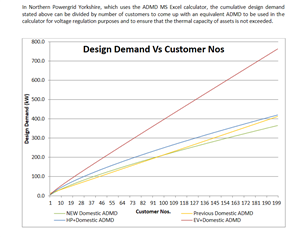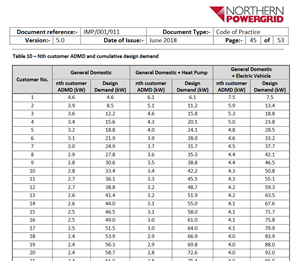

mapj1:
You can down-rate most car chargers to 16A 3.6kW if the supply isn't up to a 32A 7.2kW fast charger. That should still be fast enough for most people
That is true, but the ADMD (After Diversity Maximum Demand)- that is the average power per house used to size the substations and the street mains for the 230V end of things - is not anything like as high as 16A per property, more like half that in most of the UK, so the if half of households on one substation want to charge one car at 16A,, then everything else in the street will need to be turned off to keep the substation within spec - the same point is reached when about 25% of households want to use a 32A charger.
Substation transformers can and often do ride out overloads of more than 100% (twice the nameplate current) for the odd half hour, as the thermal mass of steel and oil allows this. A long slow change is not so helpful
I predict that some serious networks re-inforcement will needed when we get beyond the current state of a few % of households having just one electric car - especially if there is a push to discourage gas for heating as well at the same time.
Mike
PS.
Surprise yourself with the ADMD figures in this PDF from UKPN see table 8-1 page 19
The data in pages 44-45 of this report on designing future proof LV networks from northern powergrid is probably more realistic than national grid, in showing a near doubling of demand above the old ADMD curves if an electric vehicle is added.
Note how under the current LV network, (yellow curve) 100 users can be fed by a 250KVA transformer with a bit in hand. With EV in use (upper red, not so curved curve) something nearer a 400kVA transformer is needed for the same no of households. The table below is the granular data to be used for when a very small no of houses share a transformer/ street cable, and a smooth curve is not applicable. I assume Yorkshire is not densely populated enough to warrant calculating the curve up to transformers of the 1MVA level just yet ?
I'm somewhat puzzled by that data and the graph. Assume everybody gives up their gas heating and petrol cars. On a winter's day, everybody will plug in their EVs, but only a handful of people will turn on their heat pumps?
mapj1:
As an average from a few datasheets of scooters and electric bikes of the 300watt/ 15 mph type, these typically seem to run for perhaps an hour and need 3 to 4 hours to recharge so the charger load is perhaps 75 to 100 watts max. for a few hours at a time. Most houses have saved more than this by changing to LED lights, and have then blown quite a lot of that saving again by leaving the ADSL router and associated internet of things kit running 24 hours per day. ?
I agree even if every house had a scooter, it would still not be very significant. Car (and even motorbike) charging, at orders of magnitude higher energies are far more of a concern.
Mike
This may well be roughly correct. Electric scooters are unlikely to place a heavy current load on the network, as they will be charged at different times of the day, but if they increase in popularity then they will be likely to make a small (but not insignificant) impact on overall energy consumption and domestic electricity bills.

vimal bhagwani:
As many companies are developing electric vehicle there should be a standard system and technology for electrical vehicle and there should be a standard tech for charging infrastructure so that it doesnot harm any electric vehicle when it is charged by different company charger.

Simon Barker:
You can down-rate most car chargers to 16A 3.6kW if the supply isn't up to a 32A 7.2kW fast charger. That should still be fast enough for most people.
It isn't. A 13 hour charge for a 150 mile vehicle is not compatible with the usage pattern of many car users. Even the average commute is 84 miles by car that's the average. You will struggle to do any miles post commute every day. Being suitable for 75% mean unsuitable for 25%. That's not a way to formulate coherent transport policy. Note: This is first hand experience.

Lee Morris:
Most modern chargers have a load management facility that can cope with this and keep the peak demand below 60A. This will likely become more of a necessity. I don’t know where you’re based as well, but we put 100s of EV chargers in, and the DNO check is normally completed for us within 2 weeks. Most of our customers who turn up a looped supply have their supply unlooped within 8 weeks and never more than 12 weeks. Obviously there are big differences across the country but there’s no reason this infrastructure can’t keep up with demand, with suitable investment.
SSE. Direct quote from them. "We cannot give a lead time as we have too many applications for load checks. We don't even have resource to understand the number of orders, let alone satisfy them." Been 2 months for me, 5 months for my neighbour. The point is not load management. For EVs to be a success the vehicle needs to be ready when the consumer wants it not when the electrical supply can charge it.
If this process isn't fixed then people will not transition. How do I know this. My partner has returned their leased EV and gone back to an ICE.
SC:Simon Barker:
You can down-rate most car chargers to 16A 3.6kW if the supply isn't up to a 32A 7.2kW fast charger. That should still be fast enough for most people.It isn't. A 13 hour charge for a 150 mile vehicle is not compatible with the usage pattern of many car users. Even the average commute is 84 miles by car that's the average. You will struggle to do any miles post commute every day. Being suitable for 75% mean unsuitable for 25%. That's not a way to formulate coherent transport policy. Note: This is first hand experience.
I don't know where you got that figure from, but I don't believe it. The only similar figures I can find are 84 minutes. But very few people will average 60MPH on their commute.
We're about to take you to the IET registration website. Don't worry though, you'll be sent straight back to the community after completing the registration.
Continue to the IET registration site